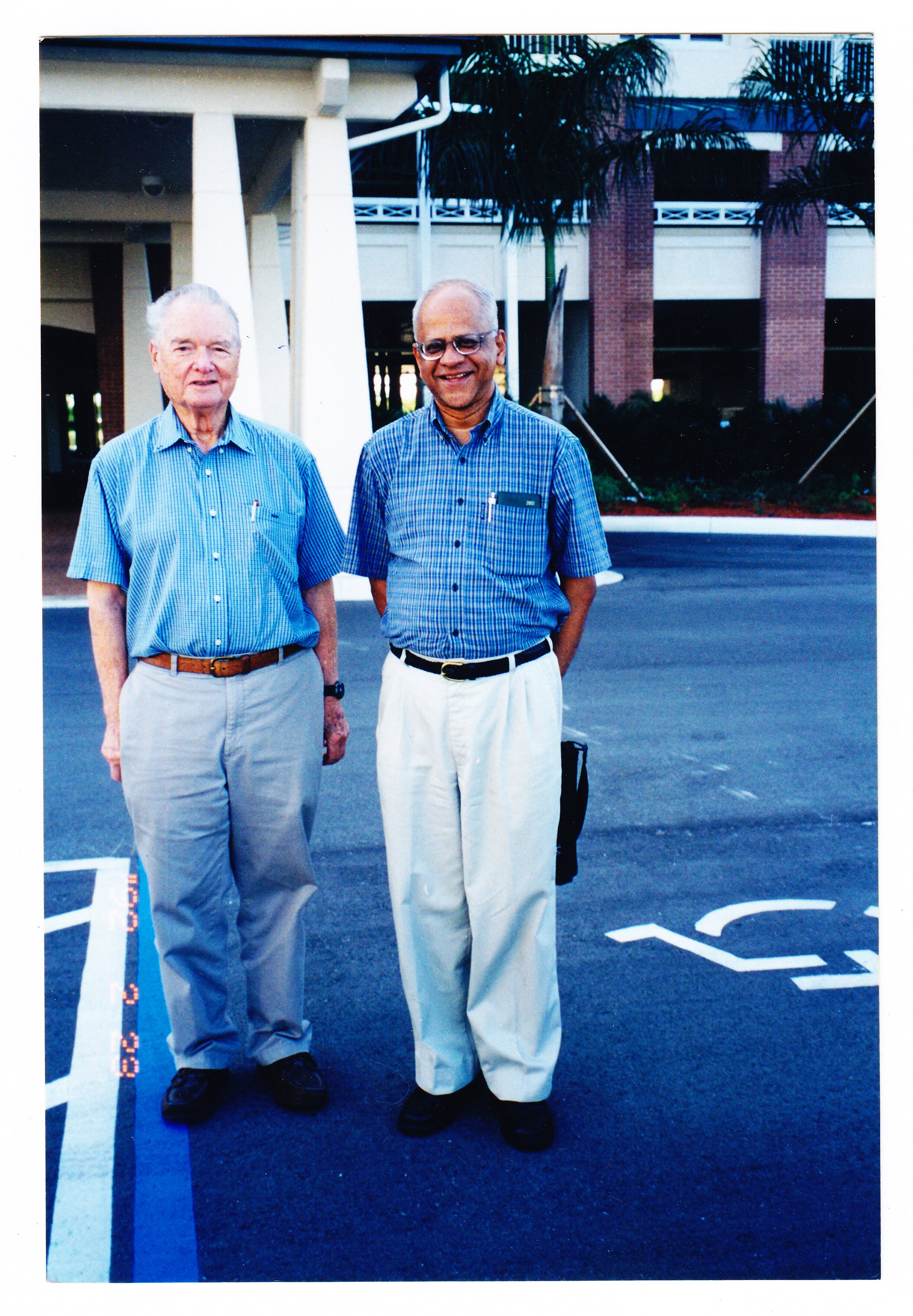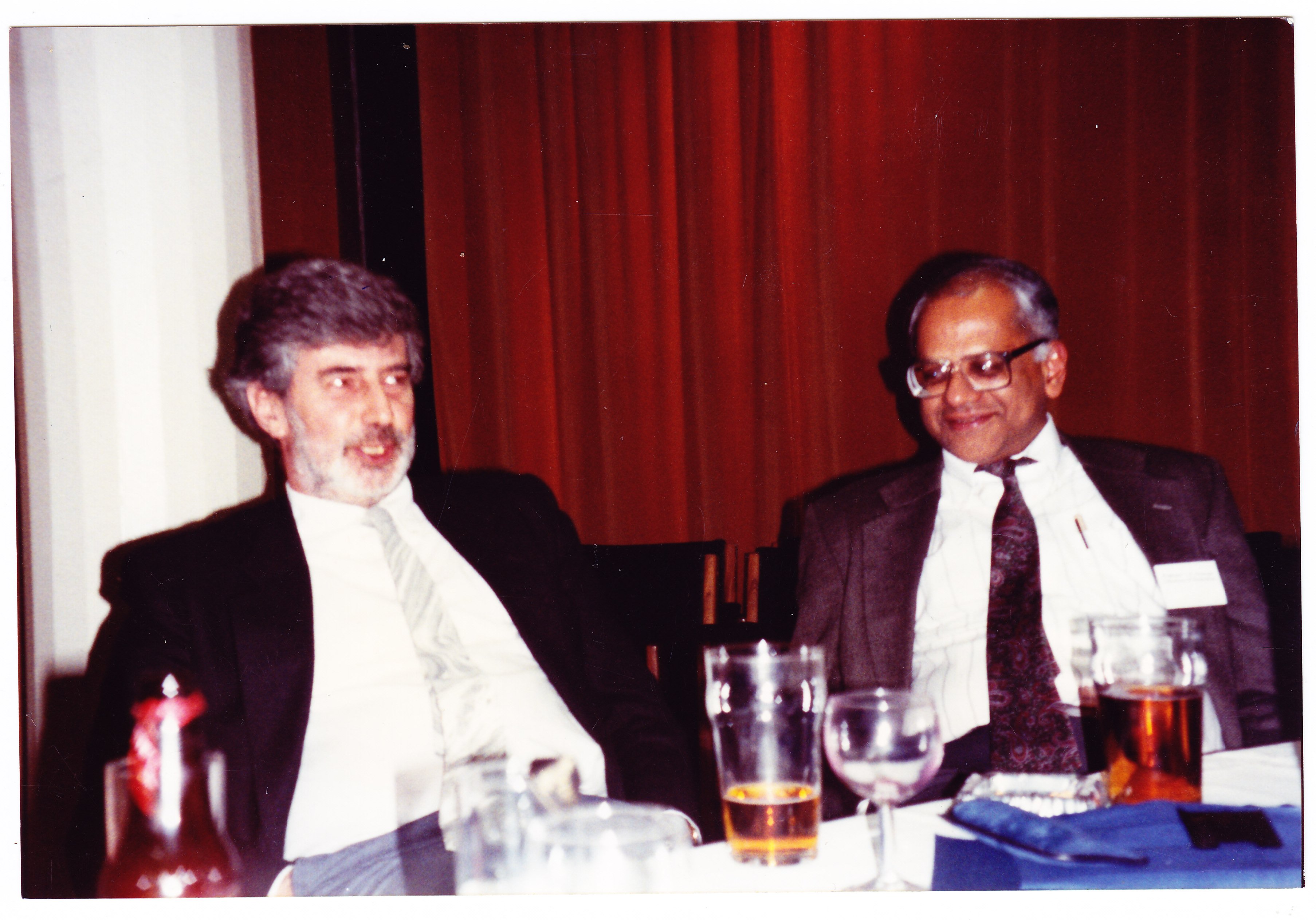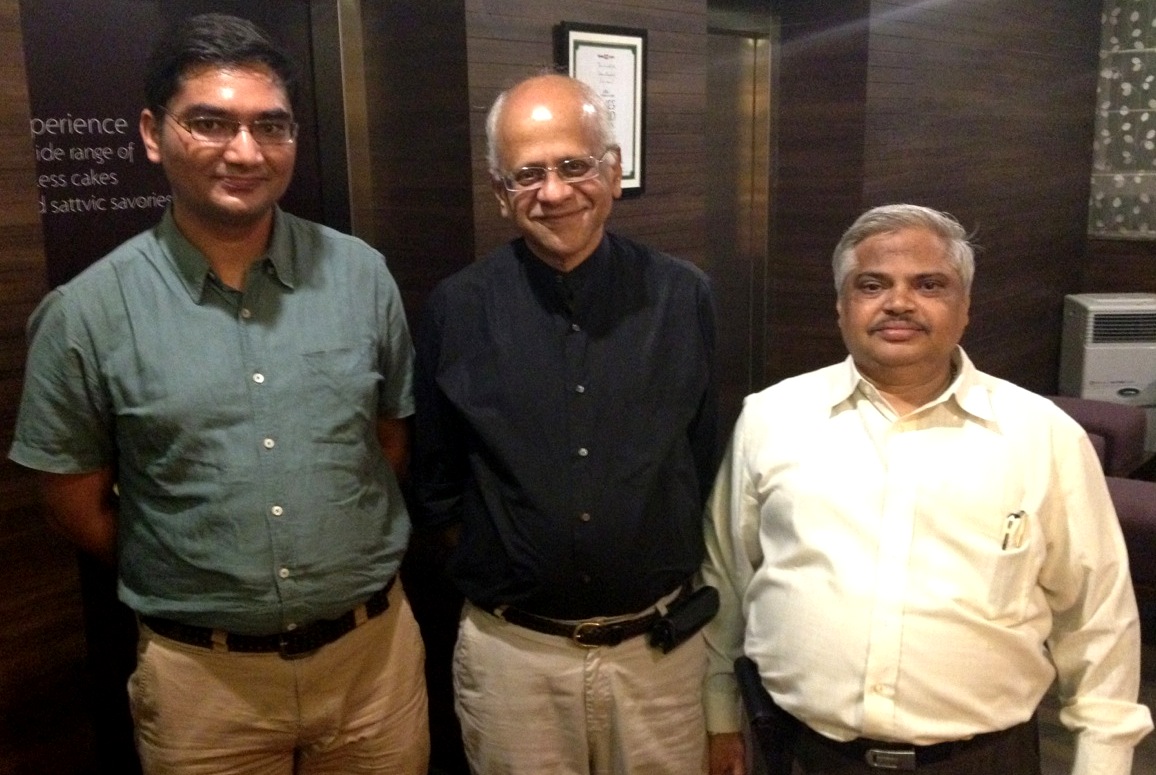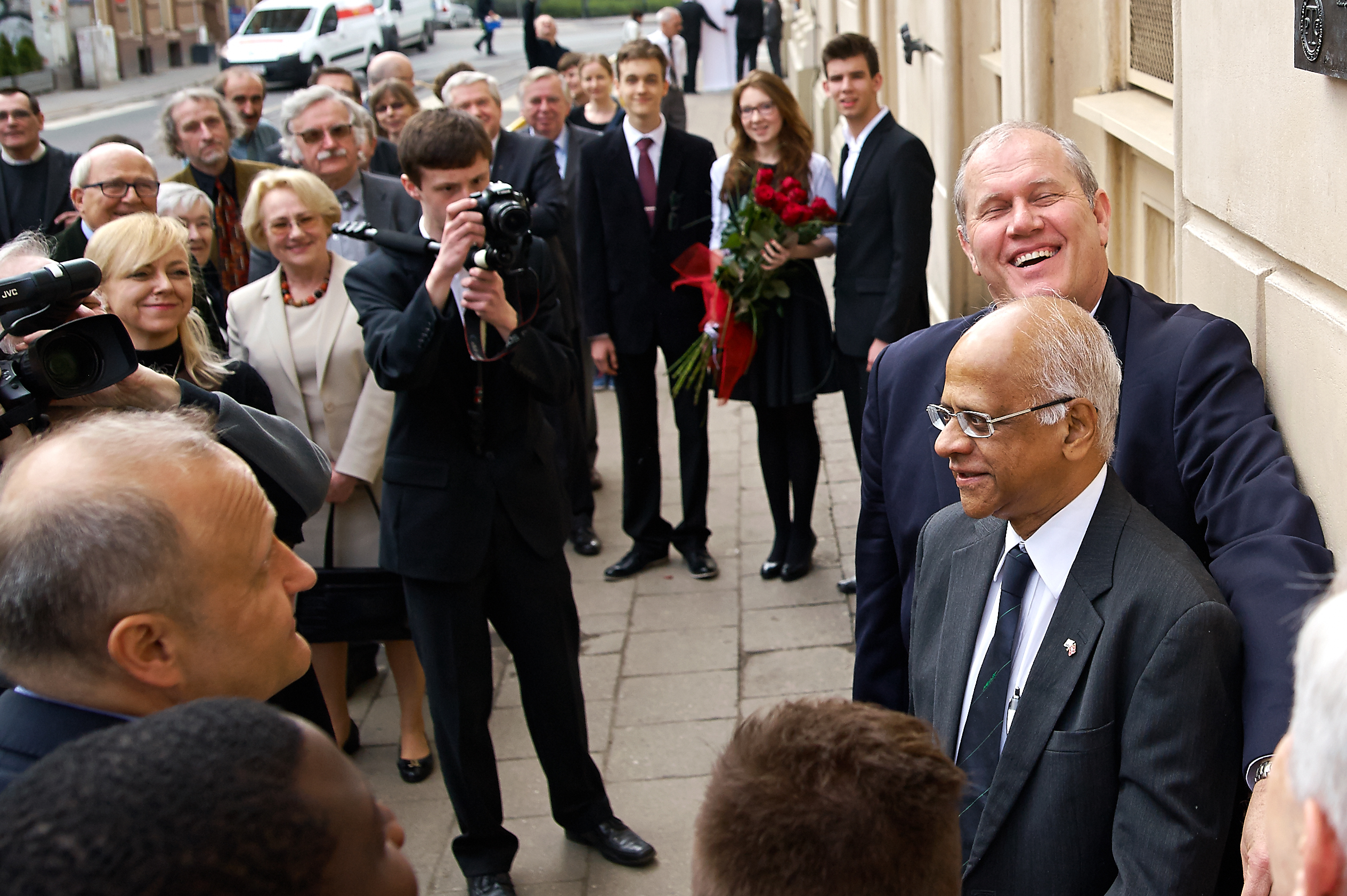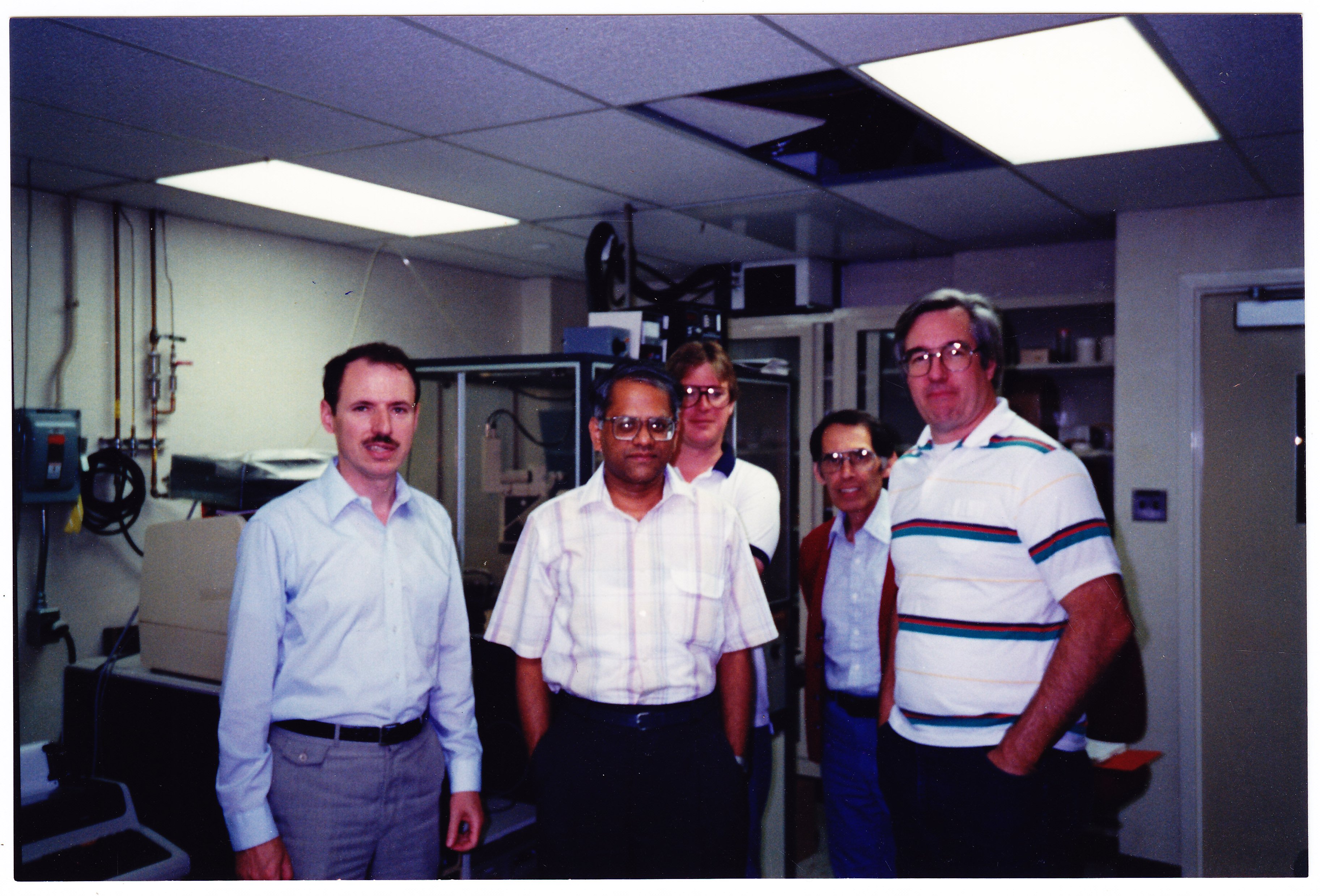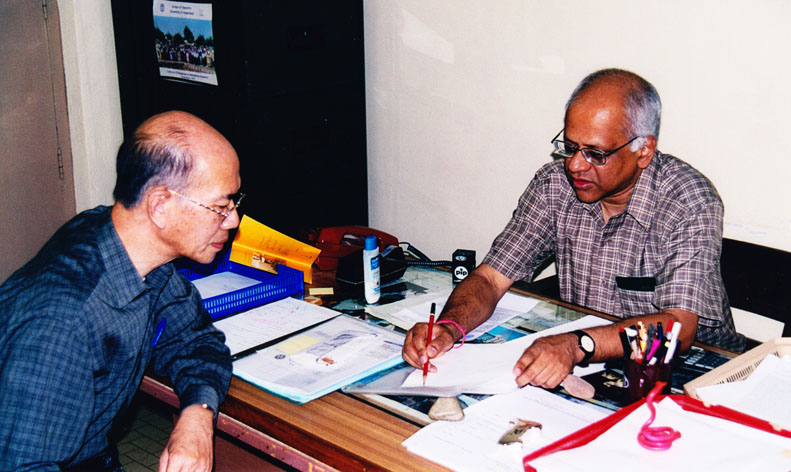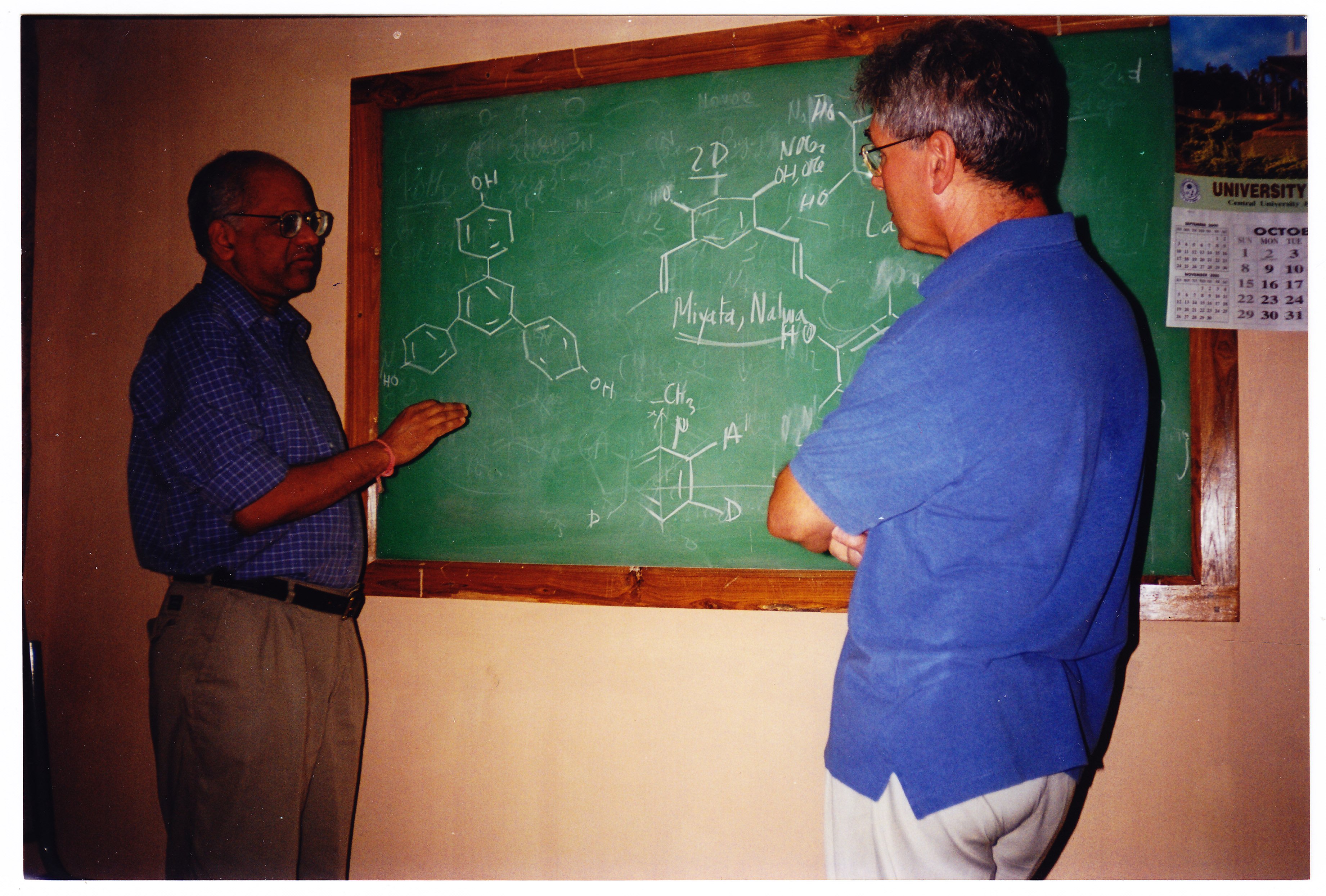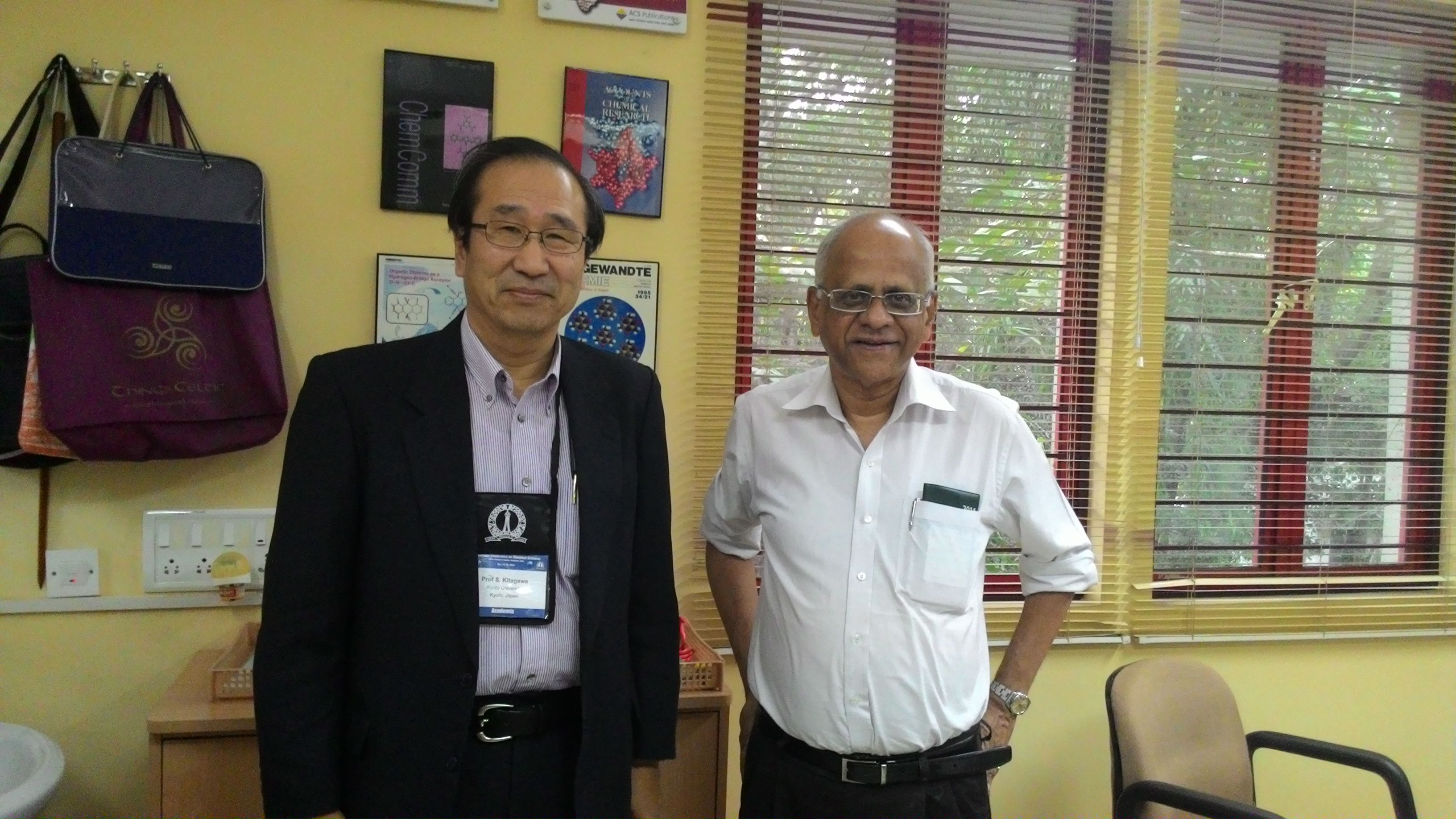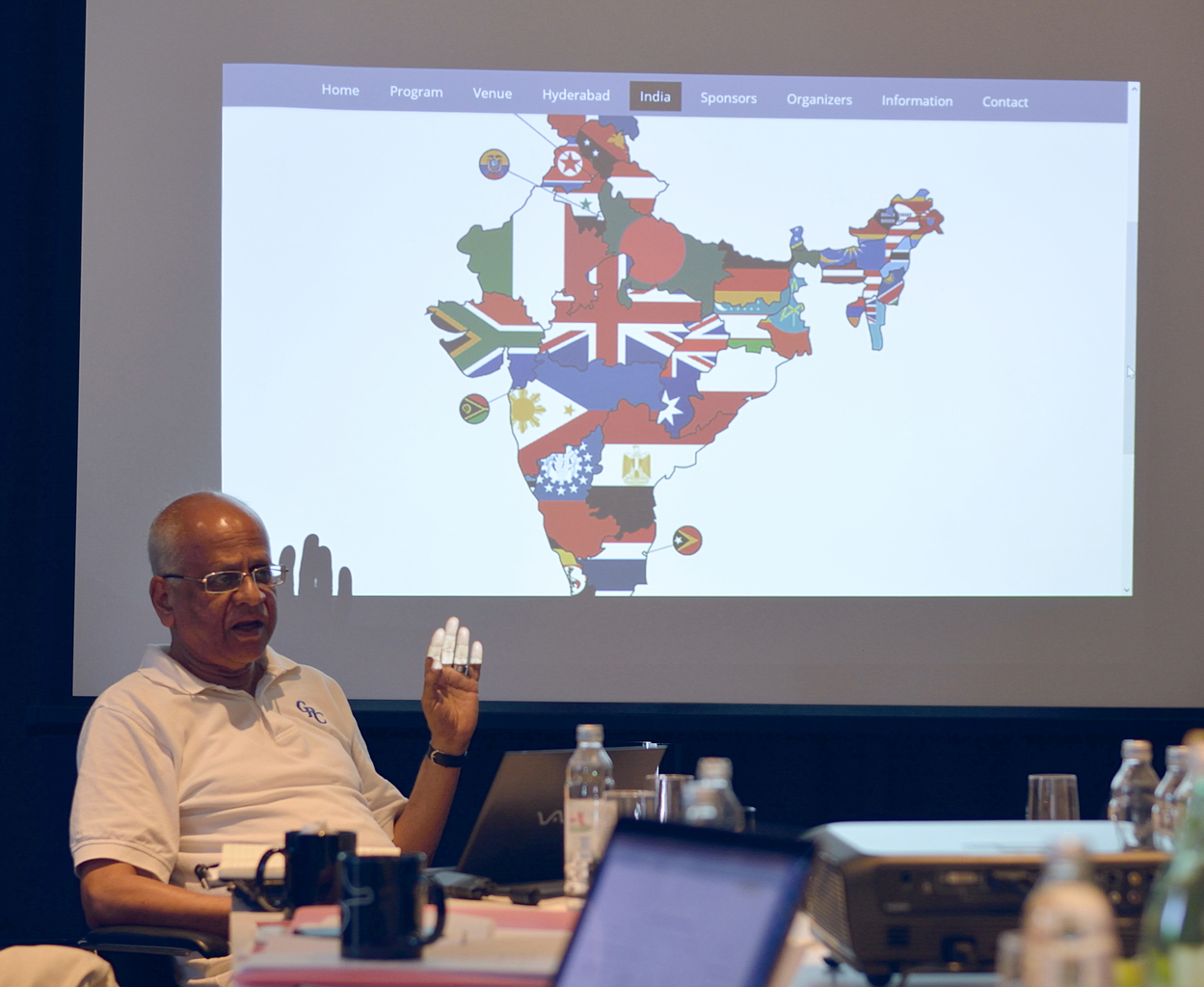Memoir - Gautam R. DesirajuMemoir | Publications | Curriculum Vitae | Videos | Slides | Articles | Obituary
ACA Living History2018
Undoubtedly, the oxymoron character of the term “Living History” was deliberately intended by the ACA. While I am reasonably sure that I am still living, I am even surer that I will not by any stretch of the imagination constitute a part of history even in the limited context of science, crystallography or chemistry. But since this is supposed to be an autobiographical essay, let me say that if I had not opted for chemistry as my principal subject in college, I probably would have studied history. History still attracts my attention, and I find it to be fascinating, especially since I come from a country with such a rich and complex history, which is still revealing itself, a much better case of “Living History” than myself. But that’s another story.
Coming to myself, I have generally been reticent about conveying details of my family, upbringing or childhood activities to a professional audience, because these things are properly kept outside the discourse. So I will merely say that I was brought up in Madras and Bombay (I still use the old names because I don’t think one can change history by changing place names) in the 1950s and 1960s in an upper middle class family that was no different from thousands of other such families in India, and I was, as is common, influenced by my parents and teachers. Research scientists need a lot of “consideration” and “sympathy” from their families if they are to function effectively. In this regard, I have been extraordinarily lucky in my wife Krishna for all her understanding and support over the years, which has included shielding me off from the “normal” world.
Coming to professional things now, I got into a Boeing 747 airplane in 1972 at the advanced age of 20 and travelled halfway across the world to study for a PhD in chemistry at the University of Illinois in Urbana-Champaign. This was my first journey outside India. It was a culture shock. Bombay was, even then, a huge city with 6 million people. I had lived in an upmarket neighborhood and all I had seen were multi-storied buildings, suburban trains and a lot of traffic. Urbana seemed to be a hick town, actually a village, with just 100,000 people, some cars here and there and hardly any high-rise buildings, maybe just a handful. It was a small campus town with a third of it being connected directly with the university as students and teachers. The second shock, but in reverse, was the academic atmosphere there. With an undergraduate degree from a renowned but still unpretentious (in research terms) college of Bombay University, I had been suddenly thrust into one of the most prestigious and advanced chemistry departments in the U.S. In one of the first seminars I attended there, the speaker said that he was happy to be invited to the best chemistry department between Harvard and Berkeley! The year I joined, there were 110 PhD admissions, and I was the only one from India—sounds strange in today’s globalized world, doesn’t it? In such a place, one had to swim or sink. I guess I swam.
Unusually, I had two joint advisors for my PhD, David Curtin whose name still lives as the Curtin-Hammett Principle and Iain Paul, a younger crystallographer, who had studied under the legendary J. M. Roberston in Glasgow and then gone on to be a part of R. B. Woodward’s group in the B12 project. The Curtin-Paul group was one of the very few in the world who at that time were working in an area they called organic solid state chemistry. I guess I got used to the idea from them, of working in areas that no one really knew about, understood or really cared about even. I do feel that big progress in science comes from working in areas that are not easily definable in terms of standard labels. Today’s bridging areas become tomorrow’s mainstream.
Anyway, for those of you who remember crystallography in the 1970s, my very first crystal structure was determined on a big Picker single-crystal diffractometer: you needed to climb a wooden step to mount and align a crystal, and to manually set the four angles of the initial 25 unit cell defining reflexions before the computer drove the crystal to each of them one by one. This crystal had a long axis of 44 Å! Each reflection practically merged into the next one along the long axis. I haven’t seen a cell axis this big after more than a thousand crystal structures that have come out of my research group in the last 38 years. Just goes to show.
With Professor David Curtin, Fort Myers, FL, 2003.
Anyway, moving along, around halfway through my short PhD tenure of three and a half years, a new object arrived in the lab. This was an automated computer controlled Syntex P21 diffractometer. Suddenly, the same structure that used to take several weeks/months to complete with paper tapes, card punch machines and so on, if all went well, could get solved in a few days’ time. This was a revelation but I thought no more of it for another few years. Like many other Indian students in the U.S. in those days, I wanted to make a career of it in the U.S. and indeed I was one of the lucky few in Illinois to get an industry placement, actually two, one at 3M in Minneapolis and the other at Eastman Kodak in Rochester. It seems funny, to think about this now, but I declined the position in 3M because I thought it would be too cold out there in Minnesota and that Rochester would have a nice climate. Just tells you how little I knew about the weather patterns in the U.S. then!
Rochester was bleak and grey most of the time, but this is not what impelled me to quit the job after two years and return to India cold turkey with no job in hand, and with no prospects of getting one either. While the work environment in Kodak was fine and my colleagues friendly, I wasn’t happy about being in industry all my life and the prospects for an academic job for me in the U.S. were close to nil. So I returned in 1978, spent a year as a research fellow in the Indian Institute of Science, Bangalore (to which organization I returned in 2009) before taking up a position as lecturer in the fledgling University of Hyderabad, which probably gave me the job since no one else wanted it.
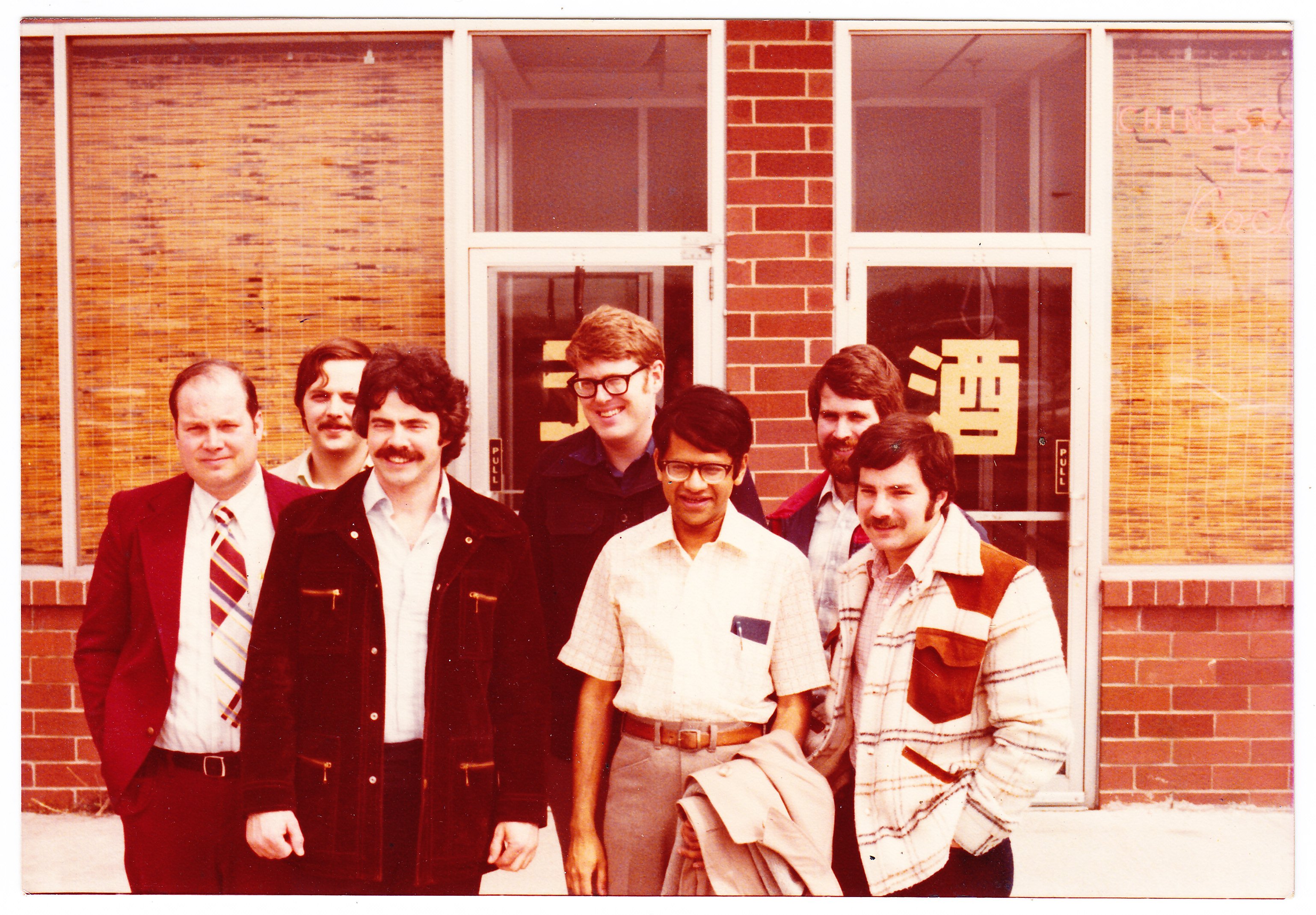 With colleagues from Kodak on the eve of my departure from Rochester, NY, in 1978.
Extreme left, Garry Byers; 2nd from left, Tim Cutler; 4th from left, Rich Anderson; extreme right next to me, Jerry Robbins.
The University of Hyderabad was a wild place in 1979. The culture shock of the corn fields of Illinois seemed tame by comparison. This university campus was a jungle, 15 km from the nearest habitation, and with no basic amenities, like permanent buildings, telephones, schools, and hospitals for many years. Yet, there were sincere teachers and devoted students who formed my peer group and despite our travails, we succeeded in nurturing one of the best chemistry departments in India in a relatively short period of time. I have written elsewhere that I did not have access to a single-crystal diffractometer at my university for 20 years: my research was shaped by this simple fact. With no instrument in my department, and yet knowing that crystal structure determination had become relatively easy for small molecules (from seeing the Syntex diffractometer in Urbana) I did all my crystallographic work in collaboration with foreign groups. The bright side of this was that I made lasting friendships with many talented and serious crystallographers from all over the world! The other aspect of this reality was that I started thinking about the Cambridge Structural Database (CSD), which was then emerging as a research tool in structural chemistry. The seminal 1983 article by Olga Kennard, Frank Allen and Robin Taylor in Acc. Chem. Res. was a real eye-opener. One could actually think about crystallographic problems without having a diffractometer!
My first laboratory in the University of Hyderabad was in this temporary building. I was here for 10 years, 1979-1989.
I have written elsewhere about a memorable crystallography school in Erice, organized by Aldo Domenicano, Istvan Hargittai and Peter Murray-Rust in 1985. I was one of the lucky few who were able to attend this meeting. Some meetings linger on long after they are formally over. The 1985 Erice School was one of them. I think many of us small-molecule crystallographers, at least in my age group, were facing similar professional issues each from our individual situations—we had all been trained to do something, namely determine small-molecule crystal structures, but this was fast transforming from a research area to a technique. I had started thinking about “Crystal Engineering” not in terms of designing solid state reactions, as had been envisaged originally by Gerhard Schmidt, John Meurig Thomas and Mendel Cohen, but rather as an expanded discipline where one could try and correlate the structures of molecules with the crystal structures that they form. This became known as the molecule → crystal problem, and to tackle it, one needed to appreciate the properties of intermolecular interactions as they are manifested in crystal structures. We were made aware of the magnificence of the subject of hydrogen bonding by George Jeffrey, and the utility of the Cambridge Structural Database in understanding patterns of interactions in related crystal structures by Jenny Glusker. I still remember the kindness of Ken Trueblood at that meeting. I was pretty nervous talking to him and I think he sensed this—he quietly said that it was a real pleasure to talk with me and that anyway I would very soon be attending many more such meetings than he would. I felt at that time that he was just trying to put me at ease, but he might have known better. Olga Kennard was not there but Frank Allen, from her group, was and a lifelong friendship with him began at that meeting in 1985. I was greatly saddened by his passing in 2011.
Participants in the 1985 Erice Crystallography School. Lodovico Riva Di Sanseverino (first row, extreme right); Jenny P. Glusker (2nd row, 2nd from left); Aldo Domenicano (2nd row, 5th from left with glasses and tie); Istvan Hargittai behind Domenicano with dark hair and glasses; Peter Murray-Rust (on Domenicano’s left with beard and tie); George Jeffrey (white-haired man on Murray-Rust’s left).
With Frank Allen, Manchester, UK, 1993.
Hydrogen bonding is “the” principal interaction in crystal packing and its understanding is the cornerstone of crystal engineering. In the late 1980s and early 1990s, all of us in the field knew this interaction was very important. If a molecule contained good hydrogen bond donors and acceptors, hydrogen bonds would undoubtedly appear in the crystal structure. Anyone would have been able to rationalize the crystal structure in terms of strong and dependable hydrogen bonds. But the reverse was practically impossible—given a molecule, it would be extremely difficult to predict how its crystal structure was going to look like. A series of beautiful papers by Olga Kennard and co-workers told us that hydrogen bond geometries especially N–H…O were quite predictable, but the next step, namely molecule → crystal was impossible to handle, and this is the key question in crystal engineering. The graph set approach, suggested by Margaret Etter in 1990, never did appeal to me and I have shied away from it because it has seemed to me as being merely taxonomical with no predictive value. Prediction of crystal structures must arise from chemical considerations: if close packing is everything, as suggested by Kitaigorodskii, then a computer would predict every small molecule crystal structure with ease.
During 1988-89, I spent a year in Dupont CR&D in Wilmington as a visiting scientist. By that time, I had notched up a couple of papers in good journals, most notably one on Cl…Cl and C–H…O interactions in Acc. Chem. Res. with my first student J. A. R. P. Sarma but the question of obtaining an extended scope for crystal engineering was concerning me. There was, I felt, still too much emphasis on 2+2 cycloaddition reactions in the solid state. The time in Dupont allowed me to complete a book called Crystal Engineering:. The Design of Organic Solids where I wrote that directional interactions, like hydrogen bonding, move a crystal structure away from Kitaigorodskii’s close packed model, and that because of this, directional interactions provide the basis for systematic crystal structure design. This book became very well known.
With J. A. R. P. Sarma and T. S. Thakur, my first and last PhD students from the University of Hyderabad.
It’s actually impossible for me to recount all my numerous professional experiences after 1989. Within the limitations of this article I cannot possibly hope to recollect all the crystallographers and chemists I have met, the places I have been to, the band of dedicated students and post-docs I have had the privilege to work with, my fans, my detractors, my experiences with being involved in the starting of new journals, landmark papers from my group and from those of others, scientific disputes, science administration including my work in IUCr, my daily professional life in Hyderabad till 2009 and in Bangalore after that, my colleagues at work, science politics, and the general business of doing all of this out of India, which in itself would make a long story. I have rarely spent long spells outside India after 1991, a week to 10 days at the most, very often less. There is no exact English translation for the Sanskrit word karmabhoomi; an imperfect translation would be “land of one’s work” but this is what Hyderabad became for me and almost all the work, for which I acquired a certain degree of recognition, arose from my years in Hyderabad. I have tried to capture some of this, and the Bangalore years, with a few photographs at the end of this essay but I realize that this gives is a very limited picture.
Since I am unable to do any comprehensive justice to my research experiences after 1989, I have decided to focus on one particular paper I wrote in 1991, as a case study, and also to illustrate how a work may be conceived and how it may be received—and how these two features may be largely unconnected. The paper in question was called “Hydration in Organic Crystals. Prediction from Molecular Structure” and it was published in Chemical Communications in 1991; the journal, incidentally, remains one of my favorites. At one point in the 1990s, Jenny Glusker graciously told me that she was retaining her personal subscription to that journal so that she could get to read my papers there quickly.
Jenny is a remarkable scientist and human being—there is much I have learned from her in terms of prioritizing goals and in setting goals that are realistic. A week’s visit that she and her husband Don made to Hyderabad in the mid-1990s and the time my wife and I spent with them will always remain in my memory. I was really pleased to have been able to invite her, as IUCr President, to deliver the keynote lecture on 100 years of crystallography in the inauguration ceremony of the International Year of Crystallography in UNESCO, Paris in 2014.
With Jenny Glusker, Osaka, 2008.
Another ceremony in Poznan, Poland where I unveiled a plaque commemorating Max von Laue, in his primary school building there, stays on as a memory of IYCr and my time as President, IUCr. Of course, in Laue’s time, Poznan, Poland was Posen, Germany but this is history mocking at you again. Fittingly, however, the function there in 2014 was organized jointly by the crystallographic societies of Poland and Germany. Science, it would seem, had the last laugh.
As IUCr President and in commemoration of the International Year of Crystallography (2014)
The origins of my 1991 Chem. Comm. paper (incidentally, one my very few original research papers—not reviews—which are single author) actually began in my year in Dupont where their scientists wanted to determine the crystal structure of 2,5-dinitrosalicylic acid in a project connected with second order non-linear optical effects. I did this structure with two highly competent Dupont crystallographers, Joe Calabrese and Dick Harlow, two people from whom I have learned a lot. The first unusual thing about this structure is that it is non-centrosymmetric in space group C2, and the acid molecules are not held together as dimers—which would be common for aromatic carboxylic acids—but rather as catemers which are strung together with water molecules. When I tried to add a drop of water to several crystals, they would dissolve readily in this small quantity of solvent almost instantaneously. On the other hand, 5-nitrosalicylic acid remained stubbornly insoluble in water. Many strange things happening together: this is always a sign to me that there is some underlying factor that will explain all of it.
With Joe Calabrese (first row, left), Dick Harlow (first row, right) and their associates in Dupont, Wilmington, DE, 1989.
It’s easiest to quote from my 1989 book, where I postulated a possible reason for the solubility and hydration of 2,5-dinitrosalicylic acid. On page 141, I wrote “The interesting question is, of course, why this unusual crystal structure is adopted at all. A possible rationale is obtained by considering that the number of hydrogen bond donors (2) and acceptors (7) is quite unbalanced. In order that the maximum number of acceptors may be incorporated in the hydrogen bonding scheme, three-center interactions would appear inevitable. However, an alternative possibility is to redress the donor-acceptor imbalance by including a water molecule. The presence of water in the hydrogen bond pattern opens up possibilities other than the centrosymmetric motif and the crystal structure actually adopted is probably determined by the stabilization conferred by all hydrogen bonds, weak and strong”. As to any possible relationship between the high solubility of the acid and its propensity for hydration, I was silent.
Back in Hyderabad in 1989, and restarting my research group after the year-long absence in the U.S., I had time to work by myself on the CSD, and I began to wonder if the behavior of 2,5-dinitrosalicylic acid was more general. To go from the specific to the general is almost addictive to a scientist. Would compounds with a hydrogen bond donor/acceptor imbalance render a compound more susceptible to hydration? The CSD showed that of the 3696 non-metal atom containing solvates in the 1988 version of the database, as many as 2566 were hydrates. This was surprising because water is not the first choice solvent for crystallizing a molecular organic solid—many of these compounds tend not to be water soluble. Enumerating the donors and acceptors in these molecules had to be performed manually—2566 hydrates was too large a number to manage and I further narrowed the test group to 411 structures, chosen arbitrarily, on the basis of journal of publication. The histogram of these hydrated structures according to donor/acceptor ratios was revealing. There were far more hydrated structures formed by acceptor rich molecules, and it seemed to me that my extrapolation from a single compound, 2,5-dinitrosalicylic acid, was reasonable. I wrote up the result, and to my recollection, there were no adverse referee comments; the paper was published speedily. In truth, I did not think more about this paper for many years; over the first 18 years, the paper picked up just 40 citations. In the following eight years, however, it secured as many as 63 citations. Last year, it had as many as seven citations. Something is going on.
What is going on is in fact not revealed in these citation statistics, although they begin to hint at something interesting. During the intervening years, the properties of solid forms of drugs became of major interest to the pharmaceutical companies and many legal issues became connected with crystal engineering and properties of solid forms, things like polymorphism, and solvation notably hydration. The matter becomes quite simple: given a particular drug molecule, if it is possible to predict whether or not it is going to form a hydrate, then the crystallization of any particular hydrate will not constitute grounds for non-obviousness in a patent application for the hydrate. Unknown to me, pharmaceutical companies had become quite interested in my 1991 paper that had been written in an earlier era with totally different objectives in mind: crystal structure prediction and hydrogen bond patterns and propensities. If this paper was broadly correct, then it could have legal implications on patentability of new hydrates of drugs. If not, then supposedly one could keep patenting new hydrates merrily.
I suspect this is why several groups began looking at my 1991 paper more seriously, perhaps even with the idea of proving me wrong. Notably, I will recall a 2006 paper in CrystEngComm by Sam Motherwell and others from the Cambridge Crystallographic Data Centre (CCDC) where they tried to show that hydration had not much to do with donor/acceptor imbalances. However, the drawback of their paper is that it gets lost in detail, and in several subsequent conversations I have had with pharmaceutical company scientists and their attorneys, the merits or otherwise of such studies were never seriously considered. Legal arguments continue to be made on the basis of my 1991 paper. This example is possibly common in science: work gets done with certain motivations but others glean new things from the work motivated by a totally different perspective that might not even have existed when the original work was done. And citations don’t tell the whole story! Many of my papers have received many more citations than this simple 1991 single-author Chem. Comm. article,but this is the paper that seems to have attracted the attention of industry more than any other.
What I will say is that in many of these matters concerning crystal engineering and crystal structure prediction and design, one needs to go back to Kitaigorodskii who famously said that “It is more advantageous to have a rough theory applicable to most molecular crystals than a fine theory useful only for crystals of benzene and urotropin”. It’s a hard fact of life that complex systems are bedeviled by the need to simultaneously optimize both generality and accuracy. This dilemma has confronted me practically every working day of my life, and I have never hesitated to pick generality over accuracy. Even while using the CSD, I have followed this precept. An exception to the rule has never made me nervous because I feel that with a sufficient accumulation of new data, the exceptions will constitute a new rule. Not all practitioners of crystal engineering agree with me, and this is to be expected because crystal engineering itself is now a very wide subject and people come to this discipline from very varied backgrounds that have differing degrees of respect for the quantitative and the qualitative.
With Thomas Mak in Hyderabad, 1998.
With Jean-Francois Nicoud in Hyderabad, 2001.
With Thomas Steiner in Ulm, Germany, 2006.
With Susumu Kitagawa in Bangalore, 2016.
Inviting the IUCr Executive Committee to attend the 24th Congress in Hyderabad. Photograph taken in Rovinj, Croatia, 2015.
Speaking in the 24th IUCr Congress, Hyderabad, 2017.
In the 24th IUCr Congress, Hyderabad, 2017.
I feel remarkably grateful in my research career of 45 years, of which 39 have been spent in pursuing independent research. Many a time I have chosen the road not often travelled and yet I have always felt exhilarated by my non-conformism. I declined admission to the prestigious Indian Institutes of Technology at the age of 17, gave up a U.S. green card at the age of 26, and refused to accept a so-called career shaping award in India when I was 43, simply because I didn’t feel these things were correct for me. I have never regretted these decisions and on the contrary, these experiences have enabled me to see life in its entirety and as I have said in one of my better known papers, in a “holistic” manner. It’s practically a cliché for an Indian to quote Mahatma Gandhi but my favorite quotation from his works is “Be the change you want to see”. During my years in Hyderabad and now in Bangalore, I have always enjoyed my interactions with my students, post-docs, associates and collaborators, many of whom participated vigorously in the very memorable 24th Congress and General Assembly of the IUCr that I organized in Hyderabad in August, 2017 with their substantial assistance and advice. Without their very real work, support and loyalty, I would scarcely have begun to be able to do anything at all. To all of them, I offer my sincere and heartfelt thanks.
With a large group of former and current students and associates in the 24th IUCr Congress, Hyderabad, 2017. |

